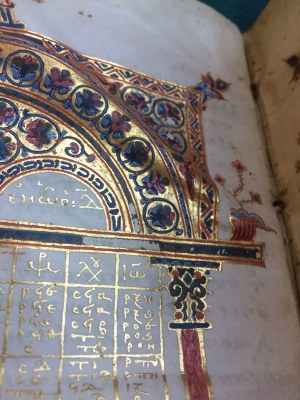Joseph Kopta // Chromatic Networks: Materiality and Materialism of Middle Byzantine Gospel Lectionaries (ca. 850–1204 CE)
My dissertation investigates the materiality of Byzantine manuscripts, specifically in terms of genesis, dissemination, liturgical and monastic settings, and modes of production. In each case, my study considers the Middle Byzantine, Greek-language Gospel Lectionaries traceable to the Rite of Constantinople in use at Byzantine monasteries between the ninth and thirteenth centuries CE. As a whole, this dissertation explores the materiality of Middle Byzantine manuscripts along two perspectives. First, it understands modes of manufacture through literary and scientific evidence, identifying the materials, especially pigments, of manuscripts through non-destructive analyses and translations of Greek-language texts about matter. Secondly, it evaluates the meanings and understandings of those materials along liturgical, monastic, and scientific-intellectual contexts in the manuscripts’ specific use in Byzantine society.
Although Western medieval recipe books (such as those by Theophilus, the Mappae Clavicula, and the recipes attributed to Heraclius) begin to answer the questions of how pigments were produced, there are some divergences in the Byzantine world regarding technique and color conception. The resulting question is whether the tradition of producing pigments and making manuscripts from recipe books extends to the Byzantine context, where such recipes are seemingly absent. In the absence of Byzantine recipe books for making and applying pigments on the manuscript page – a distinct difference from the Latin western tradition – new technical methodologies for reconstructing Byzantine conceptions of materials will strengthen our understandings of these objects in their original contexts. Specifically, I will examine the manuscripts in my study set with non-destructive analyses, using XRF technology, in order to determine the composition of the pigments present on the manuscript pages. Looking at the manuscripts using these techniques easily permits compositional analysis non-invasively and non-destructively, without touching the surface of the manuscript. Situated within the growing body of studies that engages with materiality – already well developed in Western medieval scholarship but largely underexplored in counterparts in Byzantine art history – my dissertation addresses Middle Byzantine materials and techniques as a system of matter inherited from God’s creation that is recreated on the pages of elite illuminated manuscripts. The aim of reconciling Byzantine, pre-Newtonian physics with actual pigments present on the Byzantine manuscript page will position the materiality of the Byzantine manuscript as a microcosm of Byzantine monastic liturgical practice.
